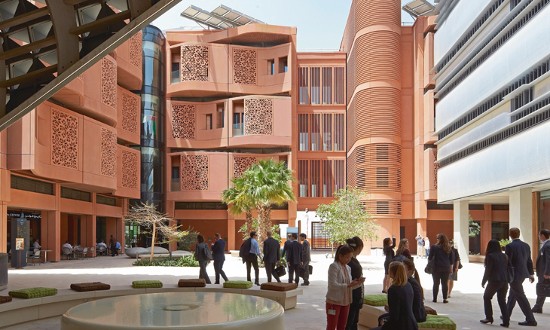The majority of humanity now lives in cities. Many of them are urban heat islands. That’s largely caused by the materials we use to create our buildings and urban infrastructure, and the shade and green spaces we create. It is about how we generate the energy we use to light, heat and cool our cities and the way we build the structures we live and work in.
Masdar City was built as a model for urban development. Just outside of the city of Abu Dhabi in the United Arab Emirates (UAE), Masdar was to be the first zero-carbon, zero-waste city in an area of the world that is already hot and expected to be even hotter. Just how hot? Abu Dhabi experiences peak summer highs of 45 Celsius (113 Fahrenheit). These are expected to increase by 2.5 Celsius (4.5 Fahrenheit) by 2050.
Masdar was a project that aimed at showing the world that the UAE could take a leadership role in transitioning to a low-carbon, sustainable future, using the immense wealth gained from its oil and natural gas exports. It was to be powered 100% by renewable energy. Its buildings set closely together with narrow roads and walkways were designed to be walkable even on the hottest days. Shaded with tree plantings everywhere, the walkways were meant to be breezeways to keep temperatures at street level 10 Celsius (18 Fahrenheit) below areas exposed to the Sun.
Masdar was meant to be an urban model for the rest of the planet. What was envisioned hasn’t exactly worked out as planned. Sustainability in Masdar remains a buzzword, not a reality. Building it proved to be very expensive and beyond the means of most of the countries in the Global South where existing cities would have to be retrofitted to enjoy any of the benefits of Masdar’s design elements.
Masdar included an enormous solar power plant, rooftop solar panels, and solar-powered street lighting. Deploying solar panels in the desert has its significant challenges. Suspended dust between 1,500 and 2,000 parts per million has decreased the energy yield from panels by 40%. To make up the shortfall, Masdar has tied itself to the UAE power grid which produces electricity in fossil-fuel-burning power plants.
Masdar was meant to be walkable supplemented by Personal Rapid Transit (PRT) electric vehicles (EV) that ran on designated lines. Less efficient than electric buses, the PRT system has proven ineffective and has been overtaken by advances in EV development. No cars are permitted in the city which means unless you are on a designated transit right of way, you need good walking shoes to get around. Fortunately, the shaded streets provide some relief from the desert heat.
Freshwater in a desert city proved to be another challenge. The city developed the Atmospheric Water Generation (AWG) system powered by solar panels. The system captures moisture from the desert air and in its earliest iterations can supply up to 1,000 litres (264 US gallons) per day. Eventually, the AWG system is expected to reach a capacity of 7,500 litres (1,981 gallons) daily. Considering the city master plan calls for a population of 50,000 by 2050, and the average consumption being a minimum of 5 litres, (not including water for trees and other plants) the AWG system will need to produce 250,000 litres (66,000 gallons) daily. The current population is around 6,000, well short of the 50,000 goal. Even with 6,000, the city needs several AWG systems to meet freshwater demands.
The attempt to create a zero-waste urban environment has had its challenges. The goal was to process 37.5 tons of municipal solid waste per hour. Material recovery was part of the plan with recycling in mind. Anything that could not be reused would be burned in a clean energy thermal power generation plant.
In a Guardian article published in 2016, its headline reads “Masdar’s zero-carbon dream could become world’s first green ghost town.” The original aim to be the model sustainable city of the future touting green credentials, is turning into a bit of a bust. The original dream has proven elusive.
I wonder how many delegates and visitors to COP28 in Dubai, will take a side trip to visit Masdar City. And if they do, can they learn from the positives as well as avoid the pitfalls of this ongoing, evolving experiment to build a sustainable city in the middle of a hot desert that is getting ever hotter?
















